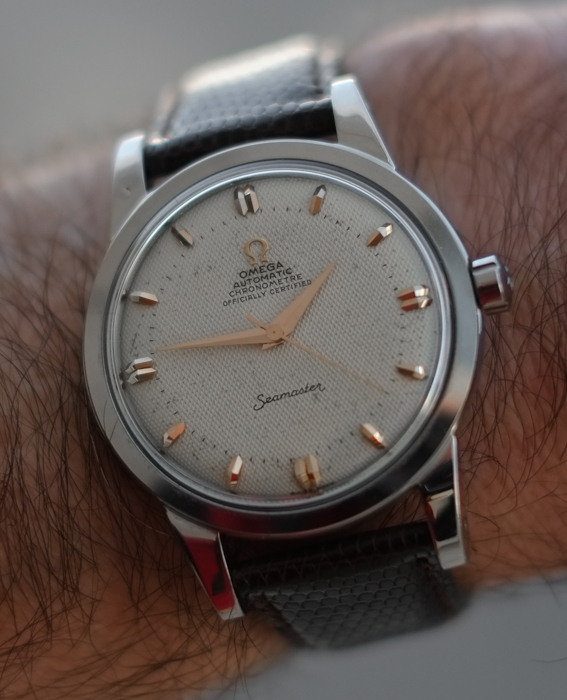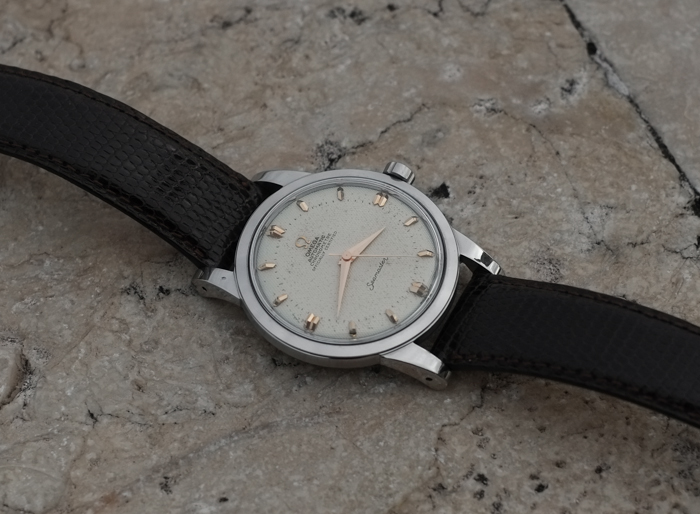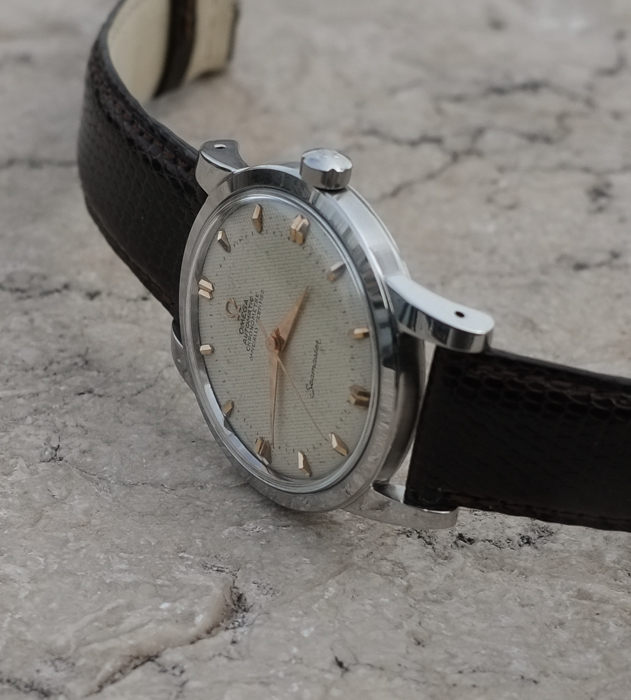Tony C.
1239

A nice early Seamaster, and a few thoughts on semantics...
As a vintage watch collector, I was blessed with small wrists. Contemporary watches are, generally speaking, too big for me, but a large majority of vintage watches work well. To be more specific, I can comfortably wear anything from around 32mm on up, but my sweet spot is 35–37mm. What that means within the context of vintage Omega watches is that some of their very best and most important offerings fit me very well. That would include the likes of the 35.5mm 30T2Rg chronometres, the 36mm Geneves, and the 36mm bumper chronometres.
I have owned a Seamaster chronometre previously, but is was 34mm. And while that size works well enough on my wrist, I like the 36mm cases more, and I also like that they are much less common. So, when given an opportunity to snag a Seamaster chronometre in the latter category, and especially one in very nice condition with pink gold dial furniture, I didn't hesitate.

As I am not at home, my photo taking abilities (especially macro) are limited, so you'll just have to take my word for it when I say that the case and movement are both in excellent condition. The dial is in very good condition, though a reasonable argument could be made that within the context of these type of textured dials, it has survived much better than most. It is a ref. 2494 (with a double case ref. 2657), is powered by a cal. 354 movement.

Now, about my reference to semantics in the title of the post. If I were ignorant about watches, or were a novice collector, and someone made mention of "dial furniture", I'd probably write him off immediately as a pompous twit. But within the context of vintage collecting, and especially after some time has passed, and an appreciation for various nuances begin to take hold, the phrase actually makes a good deal of sense.
If one were to visit an old bus station in a small American city or town and take a quick look around, the word "furniture" would not likely spring to mind. Why? Because even though there would be chairs, they would be of such a utilitarian nature, that calling them chairs would suffice. The same is arguably true of watches. There are plenty of watches that were designed economically and largely for the sole purpose of displaying the time. Such watches feature hands and markers. But when watches were designed not only to display the time, but also to adorn the wrist, and please the eye, those intrinsically utilitarian components took on an additional purpose.
This particular model, and especially the markers, illustrates beautifully why "dial furniture" can be both a useful and reasonable expression to use. There are actually 16 markers employed (not "used", mind you), as the 3, 6, 9, and 12 positions are doubled. Each one of the 16 markers are made of gold, and feature four facets (not including the sides). What this means is that the markers not only add a three-dimensional quality to the dial, but were also carefully designed to catch light in a very similar way to diamonds when used in jewelry. As one's wrist moves – even slightly – the light catches different facets while shadows overtake others. This has a very real, jewel-like effect, and catches the eye in a manner that printed dials, or even those with simple applied markers cannot.
While this is pure, possibly romantic conjecture on my part, I imagine that when these early chronometres were produced by Omega, the company wisely chose to make a statement with them, and not only in terms of accuracy. A high-class, albeit fairly simple screw-back case, a fine and interesting textured dial, matching dauphine hands and markers that arguably rivaled any that were being produced at the time by even the big three (i.e. V&C, PP, and AP).
I have looked closely through loupes at markers and hands used by a wide variety of manufactures during the Golden Era, and these are as fine as any that I have seen. It is also worth noting that I believe the gold content in the hands to have been higher than most, as they show none of the fairly typical signs of deterioration.

Finally, let's see who can identify, based on the information that I have provided, in what country this watch was originally sold. There is a small clue, but it can only be interpreted correctly by those who are aware of its significance.
Tony C.
A nice early Seamaster, and a few thoughts on semantics...

Hello Tony! What a wonderful timepiece you show and ...
Thank you for your kind words, Abel...

My admiration is exceeded . . .
Thank you, Art...

Portuguese import mark on the upper left lug

The indentation? . . .
Some further insight...

